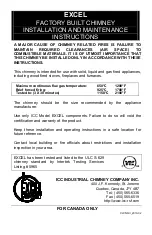
35
3
Stage
3: Ember phase
Set the rotary handle to "Reduced nominal heat
output". The combustion of the charcoal ends and
the air supply can therefore be throttled. With the
air slide in this position, rapid cooling of the masonry
stove via the chimney draw is prevented. A further
heating cycle must now be ignited again beginning
with Stage 1.
Example: efficient heating in two stages
Leave the rotary handle in the "Heat-up, max.
firing heat output", position after ignition as long as
flames can still be clearly recognised (see Fig.: 10).
Fig.: 10
Wood fire with flame
Set the rotary handle to the "Reduced nominal heat
output" position as soon as there is a bed of embers
with few flames (Fig.: 11).
Fig.: 11
Bed of embers with charcoal
19.2.5 Following combustion
When combustion has ended and no fuel has been
added, set the rotary handle to the "Closed" position.
This prevents the stove system and the living rooms
from cooling via the chimney.
19.2.6 Disposing of ashes after combustion
CAUTION: Danger of burns and fire!
The embers can glow for 24 hours and longer.
Do not dispose of ashes while hot. Carefully remove
the ashes from the stove. Dispose of ashes in closed,
non-combustible containers.
19.3 Heating in spring and autumn
In the spring and autumn, i.e. at higher outside
temperatures, fluctuations in the chimney draw can
occur in case of a sudden temperature increase,
resulting in the fuel gas not being completely drawn
off. Then fill the masonry stove with smaller quantities
of fuel and heat with the "Heat-up, max. firing heat
output" setting on the rotary handle. This burns the
existing fuel faster with the development of flames
stabilizing the chimney draw.
Masonry stove becomes too hot/fire is too
strong:
Do not attempt to extinguish the fire or remove the
fuel from the masonry stove.
Set the rotary handle to "Reduced nominal heat
output" to reduce the flame (heat).
Open all windows to dissipate additional heat.
Call the fire brigade at the latest when smoke or fire
exits from the system.














































